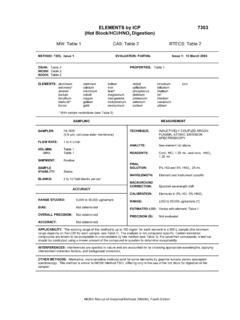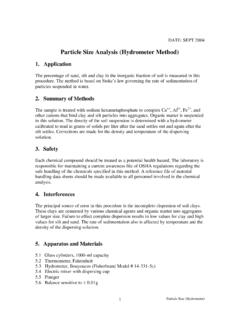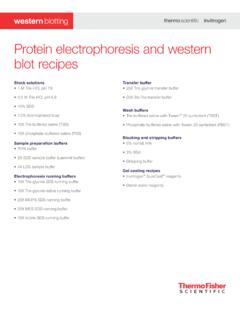Transcription of NITRIC OXIDE and NITROGEN DIOXIDE 6014
1 NITRIC OXIDE and NITROGEN DIOXIDE6014NO MW: CAS: 10102-43-9 RTECS: QX0525000NO2 10102-44-0 QW9800000 METHOD: 6014, Issue 1 EVALUATION: FULLI ssue 1: 15 August 1994 OSHA :25 ppm NO; C 1 ppm NO2 NIOSH:25 ppm NO; 1 ppm STEL NO2 ACGIH:25 ppm NO; 3 ppm TWA, 5 ppm STEL NO2(1 ppm NO = mg/m3 @ NTP)(1 ppm NO2 = mg/m3 @ NTP)PROPERTIES:NO: gas; BP C; vapor density(air=1) : gas; MP C; BP 21 C;vapor density (air=1) :NO: NITROGEN monoxideNO2: NITROGEN peroxide; NITROGEN tetroxideSAMPLINGSAMPLER:SORBENT TUBES (oxidizer + 2 triethanolamine-treatedmolecular sieve)FLOW RATE:NO: L/minNO2: - L/minVOL-MIN: L -MAX:6 LSHIPMENT:routineSAMPLE STABILITY:stable at least 7 days @ 25 C [1,2]BLANKS:3 to 6 field blanks and 10 media blanks persetMEASUREMENTTECHNIQUE:VISIBLE ABSORPTIONSPECTROPHOTOMETRYANALYTE:nitri te ion, NO2-EXTRACTION SOLUTION:absorbing solution, 50 mLWAVELENGTH:540 nmCALIBRATION:standard solutions of NO2- RANGE:3 to 18 g NO2- per sample [1]ESTIMATED LOD:1 g NO2- per sample [3]PRECISION (S r):NO: [1]; NO2: [2]ACCURACYRANGE STUDIED: NO: 11-48 ppm [1]; NO2: 2-12 ppm [2] ( samples)(3-L samples)BIAS:NO: [1].
2 NO2: -2% [2]OVERALL PRECISION (S rT): [1]; NO2 [2]ACCURACY:NO: ;NO2: : The working range for NO is 1 to 50 ppm ( to 61 mg/m3) for a air sample. The working range for NO2is to 25 ppm (1 to 47 mg/m3) for a 3-L air sample. The lower sampling rate for NO is to allow collection of oxidized NO onthe back sorbent section. At the lower rate, both NO and NO2 may be determined : Any compound that reacts with the colorimetric reagents will METHODS: This method is based on that of Willey, et al. [4] and combines S321, S320, and P&CAM 231 in a revisedformat [3,5]. OSHA methods ID-182 and ID-190 use the same sampler, with measurement by ion chomatography [6].NIOSH Manual of Analytical Methods (NMAM), Fourth Edition, 8/15/94 NITRIC OXIDE and NITROGEN DIOXIDE : METHOD 6014, Issue 1, dated 15 August 1994 - Page 2of 4 , TEA, reagent , reagent acid, H3PO4, conc.
3 ,reagent grade.* (1-napthyl) ethylenediamine dihydrochloride, nitrite, solution: Dissolve gtriethanolamine in ca. 500 mL deionized water,add mL n-butanol, and dilute to 1 solution, (v/v): Dilute mL of30% H2O2 to 250 mL with deionized solution: Dissolve 10 gsulfanilamide in 400 mL deionized water, add25 mL conc. H3PO4, and dilute to 500 mL. solution: Dissolve g N-(1-napthyl)ethylenediamine dihydrochloride in 500 mLdeionized water. stock solution, 100 NO2- g/mL:Dissolve g NaNO2 in 1 L deionizedwater. *See SPECIAL : Three glass tubes, 7-mm OD, flame-sealed ends with plastic caps, with glass woolretainers:Tube A:400 mg TEA-coated molecularsieve (type 13x, 30-40 mesh)Tube B:800 mg oxidizer (chromate) toconvert NO to C:Same as Tube the tubes in series with flexibletubing.
4 Position Tube C closest to the inlet ofthe sampling pump. Tubes are commerciallyavailable (SKC-226-40, or equivalent). sampling pump, to L/min,with flexible connecting , UV-visible (540 nm), withcuvettes, 1-cm silica , borosilicate, flasks, 50-mL and other , 1-, 5-, 10-mL and other PRECAUTIONS: Concentrated acid is corrosive to the skin and mucous membranes. Handleit only in a : the sampling pump with a representative sampler in line. before sampling, break ends of sampler and attach to : NITROGEN DIOXIDE collects on the first tube (Tube A), and is thereby separated from nitricoxide, which is oxidized by Tube B and then is collected on Tube C (adjacent to thesampling pump.) at an accurately known flow rate of L/min 5%.
5 NOTE:If NITRIC OXIDE is not to be determined, a flow rate of up to L/min may be used. the sampler and pack securely for shipment. Submit adequate numbers of field blanks andmedia blanks to the PREPARATION: the sorbent from Tube A and Tube C to separate 50-mL volumetric flasks. Discard glasswool plugs and oxidizer (Tube B). absorbing solution to sample in 50-mL volumetric and bring to the mark. flask and shake vigorously for 30 sec. Allow solids to settle. 10 mL of extracted sample into a 50-mL volumetric :Start reagent blanks at this step. mL hydrogen peroxide solution, mL sulfanilamide solution, and mL NEDA thoroughly after each 10 min for complete color Manual of Analytical Methods (NMAM), Fourth Edition, 8/15/94 NITRIC OXIDE and NITROGEN DIOXIDE : METHOD 6014, Issue 1, dated 15 August 1994 - Page 3of 4 CALIBRATION AND QUALITY daily with at least six working standards to cover the range of 1 to 18 g nitrite ion per 10-mL Analyze the working standards together with blanks and samples (steps 8 through 10 andsteps 12 through 14).
6 A calibration graph [absorbance vs. g NO2- per sample]. wavelength on the spectrophotometer to 540 to zero with reagent some of the sample solution from step 10 to a cuvette and record the the calibration graph, determine the mass of NO2- in each Tube A, WA ( g), and in thecorresponding average blank, BA ( g). Similarly, determine the mass of NO2- in each Tube C, Wc( g), and average blank, Bc ( g). the concentration, CNO2 (mg/m3) of NO2 in the volume of air sampled, V (L), applying theconversion factor :NOTE:The conversion factor represents the number of moles of nitrite ion produced by 1 moleof NITROGEN DIOXIDE gas. For NO or NO2, gas concentrations above 10 ppm, use as theconversion factor [7].
7 The concentration, CNO (mg/m3), of NO in the air volume sampled, V (L), applying thefactor (MW NO/MW NO2-) and the conversion factor :EVALUATION OF METHOD:Method S321, NITRIC OXIDE , was evaluated over the range of to ppm ( to mg/m3) for samples, collected from dynamically generated test atmospheres [1,8]. The test concentration wasverified with a direct reading instrument, Energetic Sciences Enolyzer. The g oxidizer section wasfound adequate for a 60-min sampling time. NO samples had a mean recovery of after 7 daysstorage at ambient S320, NITROGEN DIOXIDE , was evaluated over the range - ppm ( to mg/m3) samples [2,7]. When an atmosphere at 84% RH containing ppm NO2 was sampled at , breakthrough occurred after 60 min and breakthrough occurred after 180 min.
8 Quantitative recovery was obtained for samples containing 47 g NO2 which were stored for 12 days atambient Manual of Analytical Methods (NMAM), Fourth Edition, 8/15/94 NITRIC OXIDE and NITROGEN DIOXIDE : METHOD 6014, Issue 1, dated 15 August 1994 - Page 4of 4 NIOSH Manual of Analytical Methods (NMAM), Fourth Edition, 8/15/94 NITRIC OXIDE and NITROGEN DIOXIDE : METHOD 6014, Issue 1, dated 15 August 1994 - Page 5of 4 REFERENCES:[1]Backup Data Report for NITRIC OXIDE , S321, prepared under NIOSH Contract No. 210-76-0123.[2]Backup Data Report for NITROGEN DIOXIDE , S320, prepared under NIOSH Contract No. 210-76-0123.[3]NIOSH Manual of Analytical Methods, 2nd ed., Vol. 4, Methods S320 and S321. Departmentof Health, Education, and Welfare.
9 DHEW (NIOSH) Publication No. 78-175.[4]Willey, , McCammon, and Doemeny, Am. Ind. Hyg. Assoc. J. 38, 358 (1977).[5]NIOSH Manual of Analytical Methods, 2nd ed., Vol. 1, P&CAM 231, Department of Health,Education, and Welfare (NIOSH) Publ. 77-157-A (1977).[6]OSHA Analytical Methods Manual, 2nd ed., Part 2, Vol. 2, ID-182 and ID-190, Department ofLabor, Salt Lake City, UT (1991).[7]Gold, A., Anal. Chem. 49, 1443-1450 (1977).[8]NIOSH Research Report - Development and Validation of Methods for Sampling and Analysis ofWorkplace Toxic Substances, Department of Health and Human Services, Publ. (NIOSH) 80-133 (1980).METHOD REVISED BY:W. J. Woodfin and M. E. Cassinelli, NIOSH/DPSE; Method S321 validated under NIOSH Contract Manual of Analytical Methods (NMAM), Fourth Edition, 8/15/94













